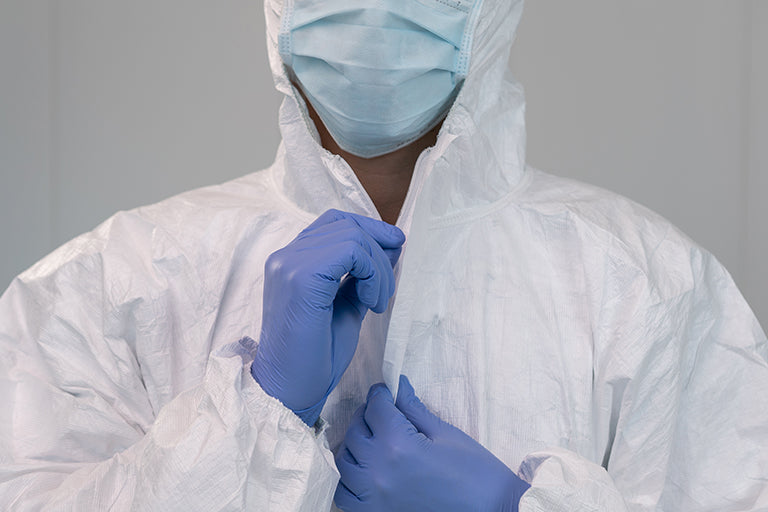

· By Trevor Horne
Medical PPE Best Practices
Personal protective equipment, or PPE, is worn to minimize exposure to hazards that can cause serious injuries and illnesses. These may include eye protection, gloves, masks, gowns, and more.
PPE is essential every day for workers in several industries, including the medical system and pharmaceutical industry. However, PPE has been under the public spotlight due to the recent COVID-19 pandemic.
Having good quality PPE is crucial for protecting staff and patients, but there is more to successful protective gear than simply choosing high-quality products. Even the highest calibre of PPE can be rendered useless from improper use.
Thus, following simple best practices regarding correct PPE use can help you and your organization ensure safety for everyone.
Types of PPE Used in Healthcare Settings
PPE works by creating a barrier between the person and the infectious material. Common types of PPE worn in healthcare settings include:
- Masks to protect the mouth and nose
- Gloves to protect hands
- Gowns to protect skin and/or clothing
- Face shields to cover the entire face, including the mouth, nose, and eyes
Medical-Grade Masks
Medical-grade face masks are disposable and designed for single use only. Each mask usually has three plies or layers, an adjustable nose wire, and ear loops or head ties.
The layers in the mask help provide filtration and act as a barrier from airborne particles and bacteria.
Face masks should be well-fitted and feel snug against the user’s face. They should be large enough to cover the nose, mouth, and chin completely and without gaps so that no air can leak in and out of the sides.
When donning a mask, take a few seconds to make sure it is secure and snug around your face, so no further adjustments are necessary during use. If you have facial hair, you may consider a beard cover in addition to a face mask to achieve a better fit.
When removing a face mask, the front of the mask is considered contaminated and should not be touched. Remove by handling the ties or ear loops only, then lift the mask away from the face and discard it appropriately.
Gloves
Gloves are one of the most common types of PPE found in healthcare settings. They may be made of vinyl, latex, or nitrile. However, due to allergy concerns, some facilities have limited their use of latex products.
Gloves should always fit the user’s hands comfortably—not too loose or too tight. They also should not be torn or damaged. Most gloves can withstand several hours of use before they need to be changed.
However, if you notice that they are heavily soiled or starting to tear, change the gloves before continuing a task.
Keep in mind that while gloves can protect you from contact with infectious materials, they can become a means for transmitting diseases once they're contaminated. To limit opportunities of touch contamination, do not touch clean surfaces, touch your face, or adjust PPE with contaminated gloves.
Similarly, always change gloves after use on each patient and discard them appropriately. Single-used gloves should never be washed, as it does not necessarily make them safe for reuse and can make them more prone to tearing.
Remember to take extra care when removing gloves to prevent contamination. Remove them at the wrist, then turn them inside out as you roll them down and off your hand.
Gowns
Disposable gowns reduce the chances of contaminating exposed skin and clothing. They should cover the torso fully and fit comfortably over the body, with the sleeves fitting snugly at the wrist.
When donning a gown, make sure that the garment’s opening is in the back and secure the ties at the neck and waist.
For safe removal, unfasten the ties at the back with ungloved hands, then slip the hands underneath the gown at the neck and shoulder area to peel it away. Slip one hand under the cuff of the opposite arm and pull the hand into the sleeve to hold the gown from inside.
Reach across and push the sleeve off the opposite arm. Finally, fold the gown inside out and roll it in a bundle for safe disposal.
Face Shields
Face shields are used when skin protection and mouth, nose, and eye protection are needed. It should extend from the forehead to below the chin and wrap around both sides of the face to provide complete protection.
When donning a face shield, position it over the face and secure it on the forehead using the headband. For safe removal, use ungloved hands to hold the headband and lift the face shield away from the face.
The Sequence of Donning and Removing PPE
The sequence in which you put on and remove PPE can affect the effectiveness of the equipment.
In general, remember to don PPE before entering the room or having contact with a patient, and remove PPE carefully either at the doorway or immediately outside the patient’s room.
The recommended sequence for donning PPE is as follows:
- Gown
- Face mask
- Face shield
- Gloves
Keep in mind that the combination of PPE used, and therefore the sequence for donning, may vary depending on the precautions taken.
Similarly, there is a recommended sequence for removing PPE to limit self-contamination. It is as follows:
- Gloves
- Face Shield
- Gown
- Face mask
Hand hygiene should always be performed after all PPE is removed.
ProNorth Medical is a trusted medical PPE supplier in North America. Our PPE products are tested and validated in Canada to ensure that they meet the utmost quality standards. Contact us at 844-537-0493 or email us at info@pronorthmed.ca for more information today.
